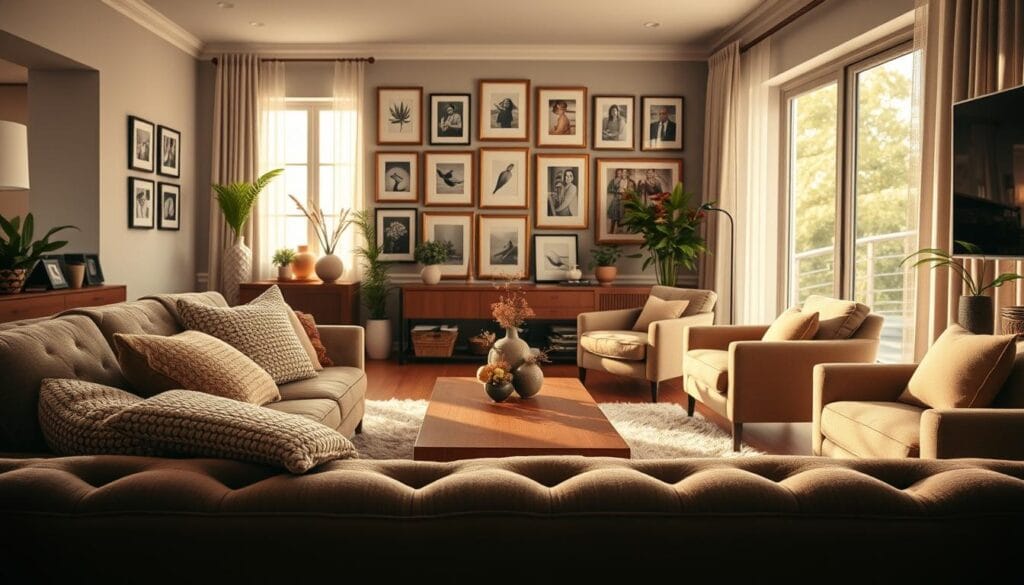Imagine coming home after a long day. The warm glow from your lamp fills the living room, creating a cozy space. Walking into the kitchen, lights under the cabinets brighten your countertops. It makes cooking enjoyable. Outside, string lights and lanterns make your backyard inviting for evenings with friends.
The Power of Lighting is about more than just seeing in the dark. It changes how any space feels, from a room that helps you focus to a home that feels safe and snug. A study found 70% of homeowners think lighting shapes their mood and productivity. It’s not just about making spaces bright. It’s about using light to make our homes fit our lives and feelings.
Let’s look at how different lights can create the right feeling in every part of your home. It can turn your space into a place full of warmth, energy, and creativity.
Understanding the Importance of Lighting in Interior Design
Lighting is not just about seeing clearly. It’s a tool used to create a specific atmosphere in your home. Good lighting design can make a room feel warm and inviting or full of energy. For instance, effective lighting design balances function and beauty to elevate your home’s decor.
The Psychology of Light
Did you know lighting affects how you feel? Bright, cool-toned lights help you focus, ideal for work or study areas. Meanwhile, soft, warm lights make spaces like living rooms and bedrooms cozy and relaxing. Knowing this can guide you in picking suitable lighting for different rooms.
How Lighting Affects Mood
Lighting does more than just light up a room. Warm white light creates a peaceful space, perfect for evening relaxation. In contrast, cool white light can wake you up, making it great for mornings. Natural daylight boosts mood and energy, so letting in as much as possible is beneficial.
Different Types of Lighting
A well-designed room includes a mix of light types:
- Ambient Lighting: The base layer that sets the room’s mood. Options include ceiling fixtures and sconces.
- Task Lighting: Provides focused light for specific tasks. Desk lamps and kitchen under-cabinet lights are examples.
- Accent Lighting: Highlights art or architecture with spotlights or picture lights.
- Decorative Lighting: Adds visual appeal while balancing practical light needs.
- Smart Lighting: Offers easy control over light settings, combining convenience with energy savings.
Working with leading brands, we ensure our lighting systems are top-notch. This partnership helps bring our creative ideas to life effortlessly.
Natural vs. Artificial Lighting: Pros and Cons
Understanding the differences between natural and artificial light is key for your home. Good lighting makes us feel happy and full of energy. But there are good and bad sides to both types of lighting.
Benefits of Daylight
Natural light is great for many reasons. Workplaces with a lot of natural light make people up to 15% more productive. It also improves mood by around 20%. And, homes with big windows seem 25% bigger.
Using mirrors can spread natural light by up to 30%. Skylights boost sunlight in a room by about 50%. However, too much artificial light at night can mess with sleep for many in the U.S. Getting enough natural light in the day can improve sleep by 30%.
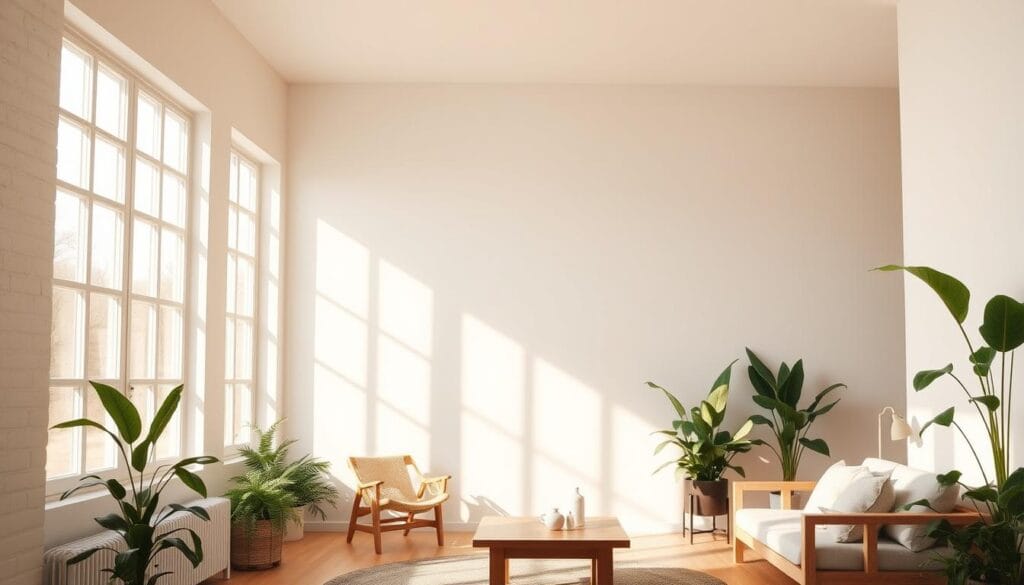
Modern Artificial Lighting Solutions
When there’s not enough natural light, artificial lighting helps. Artificial lighting makes up 15% of the world’s electricity use, but it’s practical. For instance, LED lights use 75% less energy than old bulbs and last over 20 years.
Smart lights save 30% energy compared to old systems. They can also copy daylight, making your home feel better. The U.S. Department of Energy says artificial lights use 75% of electricity in business buildings.
Since we’re indoors about 90% of the time, choosing efficient lighting is important. Bad lighting can hurt 50% of people’s eyes, so it’s not just about how it looks but also health.
Techniques for Creating Mood with Overhead Lighting
Lighting plays a key role in interior design. Overhead lighting can change a room’s feel. Whether you want a calm vibe or to add energy to a room, it’s about the right lighting. Let’s explore how choosing and installing the correct lighting can improve your home.
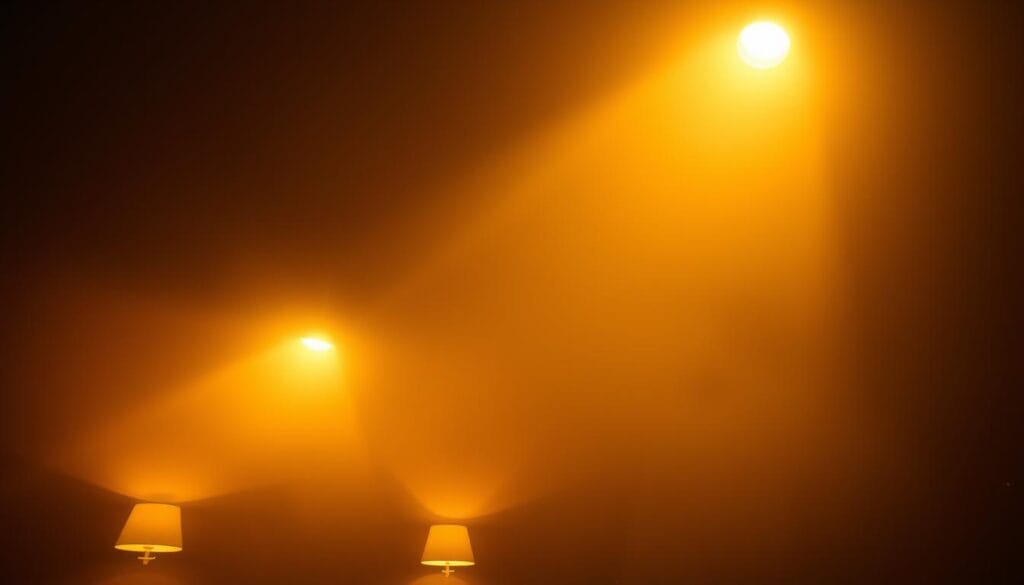
Choosing the Right Fixture
Choosing the right lighting fixture is vital. Your choice of overhead lighting, like chandeliers or pendant lights, impacts the room’s look and function. Consider this:
- Chandeliers: Great for a big impact in dining rooms or entryways.
- Pendant Lights: Best for over kitchen islands or dining tables, they focus light where you need it.
- Recessed Lights: They fit into the ceiling for a modern, clean look.
Think about the room’s style and how you’ll use it. A cozy nook might need soft light, while a kitchen needs bright, focused light.
Dimming Options for Versatility
Dimmable overhead lights can change a room’s feel quickly. Being able to control light strength lets you go from bright to cozy fast. Mood lighting can include dimmable LEDs with smart systems like Philips Hue and Lutron Caseta. Dimming lights is great because:
- Flexibility: Easily go from work light to relaxing light.
- Energy Efficiency: Lower brightness saves energy, which means longer bulb life and lower bills.
- Custom Experience: Set the perfect scene for any event, like a romantic dinner or movie night.
During sales, you can find string lights and fairy lights for cheap. LED strips offer a modern look, and most are easy to stick up. Light panels from brands like Nanoleaf are pricier but look amazing. Most smart bulbs let you change colors, creating the mood you want at home.
| Feature | Average Cost | Usability | Energy Efficiency |
|---|---|---|---|
| String Lights | Under $20 | Indoor/Outdoor | 80% More Efficient |
| LED Strips | $10+ per foot | Mounted Anywhere | 90% More Efficient |
| Light Panels | $100+ | Adhesive Installation | 80% More Efficient |
| Smart Bulbs | $10 – $50 | Integration with Apps | Variable Efficiency |
In conclusion, mixing overhead lighting with mood lighting can really change your space. By picking the right fixtures and using dimmers, you can set any mood you like.
Accent Lighting: Highlighting Features in Your Space
Accent lighting is key in upscale homes, adding a luxury feel. It makes features like high ceilings and big windows stand out. Also, 70% of homeowners say good lighting made their rooms look better.
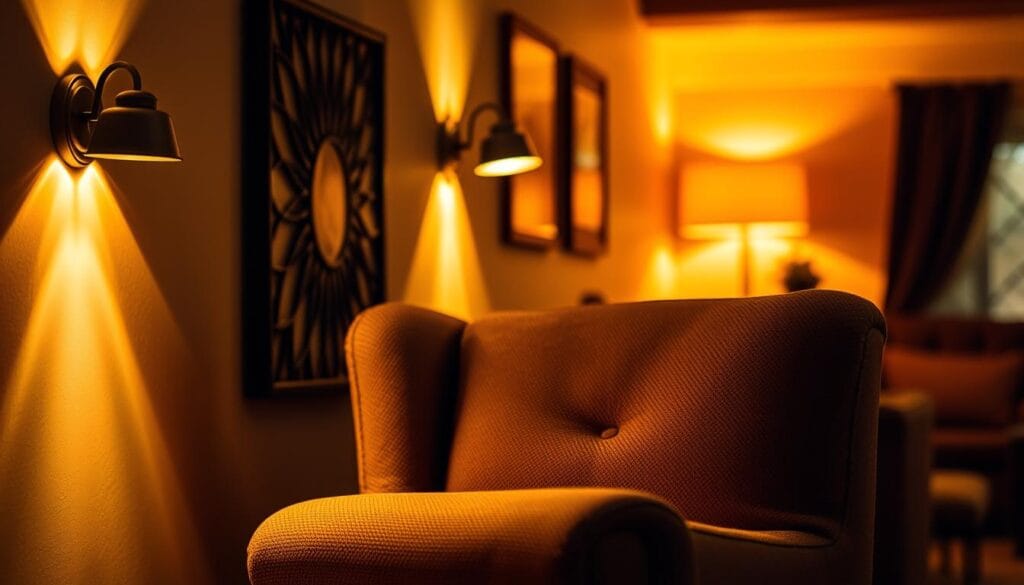
Using Spotlights Effectively
Spotlights play a big role in accent lighting. They can light up important parts of your room, like art or special design details. Using spotlights can add depth and interest, say 60% of interior designers. Plus, 55% of folks like using track lighting to show off art and change it up easily.
Understanding Color Temperature
Color temperature is important for picking your accent lights. The right color makes everything look its best. For cozy places like living rooms, 80% prefer warm light.
Together, accent, ambient, and task lighting improve a room’s look and feel. It’s about using light to meet your needs and make your space welcoming.
Task Lighting: Function Meets Style
When we talk about home design, task lighting shines because it’s both useful and stylish. It lights up our activities like cooking, reading, or makeup application, giving us the focus and brightness we need. Let’s check out where task lighting is most essential and how to place it right.

Essential Areas for Task Lighting
Putting task lighting in the right spots is crucial for its effectiveness and looks. Important places for it include:
- Kitchens: Under-cabinet lights brighten countertops, making cooking safe and easy.
- Home Offices: Adjustable desk lamps help focus light, keeping you concentrated and your eyes relaxed.
- Study Areas: Reading lamps create a cozy spot for reading without straining the eyes.
- Vanities: Lights around mirrors give even lighting for grooming activities like makeup or shaving.
Best Practices for Placement
To get the most out of your task lighting, here are top tips for where to put it:
- Focus on Functionality: Light should target the work area to reduce shadows. For kitchens, place under-cabinet lights at the cabinet front to light up countertops well.
- Adjustability: Choose lights you can move to shine where needed. Desk and swing-arm lamps in study spots are great choices.
- Blend with Decor: Pick lights that match the room’s style. Whether it’s stylish pendant lights in the kitchen or sleek lamps for study, they should fit right in with the decor.
- Consider Color Temperature: Ideal task lighting mimics daylight (3500K to 4500K), perfect for detailed activities.
Personalized and practical lighting can hugely improve your daily activities while adding a stylish touch to your home. Use the magic of task lighting to easily upgrade your space!
Ambient Lighting: Setting the Scene
Ever walked into a room and felt instantly at ease? That’s the magic of good ambient lighting. It provides a uniform light level, reducing harsh shadows and bright spots. It’s key in making a space feel just right.
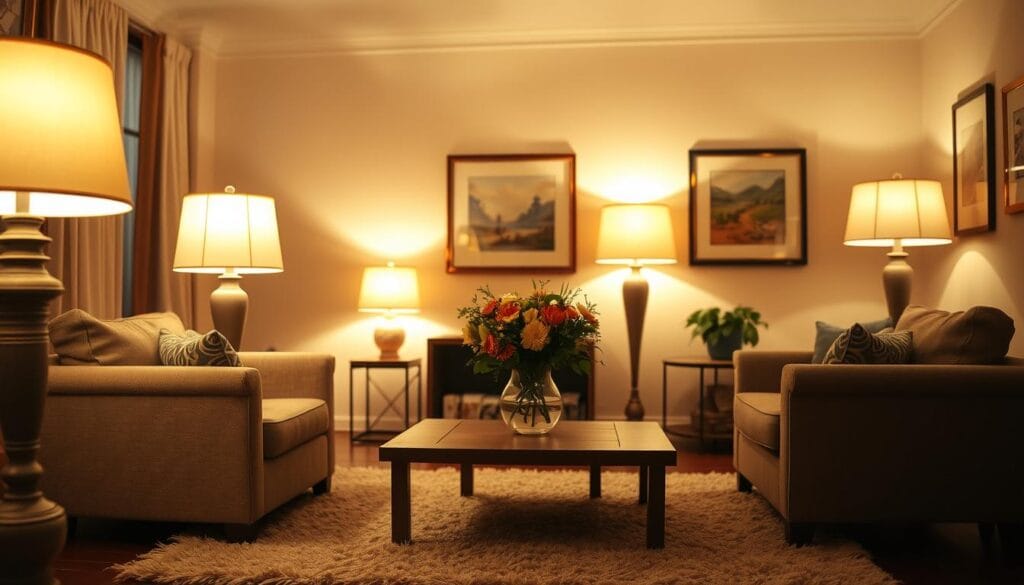
Layers of Light in One Room
A well-lit space uses many light sources for balance. Overhead lights and wall sconces work together to set the room’s mood. By mixing ambient, task, and accent lighting, a room becomes both lovely and practical.
| Lighting Type | Ideal Placement | Benefits |
|---|---|---|
| Ceiling-mounted fixtures | Living rooms, dining areas | Wide coverage, even illumination |
| Wall-mounted sconces | Hallways, stairwells | Softens shadows, adds warmth |
| LED strips | Under cabinets, behind TVs | Energy-efficient, dramatic effects |
Softening Harsh Spaces
Soft lighting turns cold spaces warm and welcoming. Using dimmers, you can adjust the light for different times and activities. A well-lit room feels and looks pleasant. Good lighting is proven to lift spirits and productivity.
Layering soft, ambient light can brighten dull areas and show off your home’s design. Plus, modern LED lights can cut your electricity bill by up to 75%. They’re a wise and eco-friendly choice.
Color and Light: Impact on Perception
Understanding the mix of color and light shapes the feeling and look of your room. The study of colors and how light affects them is central in creating the room’s mood. It’s about more than just how things look; it’s about how you feel in the space.
The Role of Color in Lighting
Color and light work together to shape how we see our surroundings. Warm colors like reds and yellows can boost energy and joy. Cool colors, such as blues and greens, help us feel calm.
For example, blue light can mess with our sleep by reducing melatonin. But, red light at night may improve our sleep by increasing melatonin.
Color Psychology and Emotions
Looking into how colors affect our feelings shows us their powerful impact. Here’s what some colors do:
- Red: This can make your heart beat faster and raise your energy, great for lively areas.
- Yellow: It boosts communication and memory, making it ideal for social and study spaces.
- Blue: Known for calmness, it promotes relaxation and can improve sleep and peace.
- Green: It relaxes the heart rate, making a space more calming.
- Purple: Great for inspiring self-awareness and personal growth.
- White: Can help with focus, but too much bright light can be too intense.
- Black: Often linked with lower energy and sometimes sadness.
Using color psychology with smart lighting choices lets you design your home’s vibe. You can create the perfect mix of mood and style by blending color and light right.
Using Lighting to Enhance Small Spaces
Lighting in small spaces can make a room feel bigger and add charm. We often think of big, bold lighting designs. But even small rooms can look great with the right lighting tricks. By using lights smartly, we can make our small rooms feel bigger.
Tricks to Make a Room Feel Larger
One way to make a room seem bigger is by choosing lighter colors for lights. Most people, 80% in fact, love natural light because it makes a room feel real. Using cool artificial lights, like those between 4000K to 5000K, can brighten up a space.
Adding different layers of lighting can also help small rooms. You should mix general lighting with task and accent lights. This mix not only meets various needs but also adds depth. For instance, 70% of kitchens use task lighting, and 40% of living rooms use accent lighting to highlight art.
Clever Uses of Mirrors and Light
Using mirrors with lights is a smart way to enhance a room. Mirrors reflect light around the room, making it brighter and seeming larger. To get the best effect, put mirrors across from light sources.
Playing with shadows and lighting contrasts can also make a room feel deeper by up to 30%. Warm lights, around 2700K to 3000K, can make cozy spots ideal for relaxing.
Adding creative lighting with smart lighting systems adds even more flexibility. The use of smart lighting has jumped by 50%, showing it is becoming more popular.
In summary, creative lighting can make a small room feel bigger and brighter. Whether it’s natural light, cool and warm lights, or smart systems, the right lighting can improve your space’s look and function. With careful planning, even small areas can sparkle as much as big ones.
Outdoor Lighting: Extending Your Living Space
Making your outdoor area a part of your home adds beauty and use. With the right lights outside, we can make a space that feels safe and welcoming. Let’s learn how to make outside spaces both cozy and secure.
Creating a Cozy Atmosphere Outside
Want a cozy yard or patio? Start with the right lights. String lights add a gentle, dreamy light for evening fun. Lanterns and candles bring a soft, close feel, and fire pits offer warmth and a central gathering spot. Lights pointing up or down can show off your home’s design or mimic the soft glow of moonlight, making everything feel peaceful.
Solar lights are great for saving on electricity and helping the planet. LED lights last a long time and are energy-efficient. This means less time changing bulbs. The right lights can make any outside gathering or quiet night special.
Security and Ambiance Combined
It’s important to have lights that make your outdoor space safe and look good. Lights with motion sensors can light up dark spots and keep away unwanted visitors. Lights along paths and around your house make it safer and reduce trip hazards. Adding beautiful lighting with these security lights makes your outdoor areas safe and attractive.
Having an expert put in your lights is best, but DIY can work well too if you’re saving money. For cool holiday lighting ideas that can inspire you, click here.
Using the right mix of outdoor lights can make your home look great and feel safe. This makes your outdoor areas inviting and secure for everyone.
Sustainable Lighting Options for Modern Homes
Choosing sustainable lights for your home is smart for both the Earth and your budget. Using energy-efficient and eco-friendly lighting makes your home look great and saves money. We can help you find ways to include these green options in your home. This helps our planet and cuts your costs.
Energy-Efficient Choices
Switching to LED lighting is a simple step to make your home more energy-smart. LED bulbs need 75% less energy than old-fashioned bulbs and last much longer. This cuts down the need for new bulbs and saves a lot of electricity. By choosing LEDs, you save money and make your home more eco-friendly.
Also, many new lights use materials like reclaimed wood or recycled glass. With 60% of newer lights being eco-friendly, picking these options shows you care about the future. These choices not only help the planet but also make your home unique. They blend green values with stylish looks.
Smart Lighting for Eco-Friendly Living
Smart lighting systems amp up energy savings. They let you control lights from anywhere and adjust settings to save power. Automated control means lights only turn on when needed, cutting energy use by up to 30%. You’ll save money and energy by not lighting empty rooms.
Smart lights also improve your home’s security by mimicking occupancy when you’re gone. This can make your home less of a burglary target. Smart lighting pairs high-tech with eco-friendliness for a secure, efficient home.
Curious about sustainable lighting? Learn more about adding green elements to your space here. Let’s choose to light our homes in ways that are good for both the environment and us!



